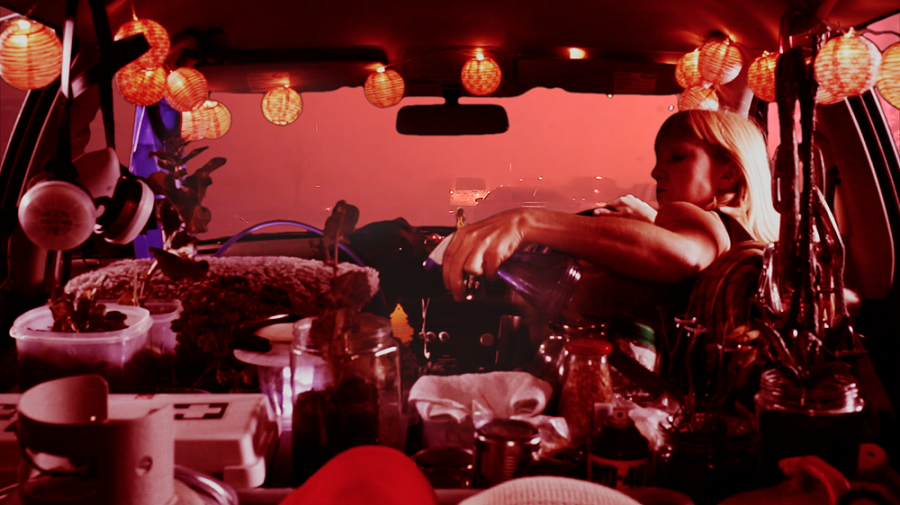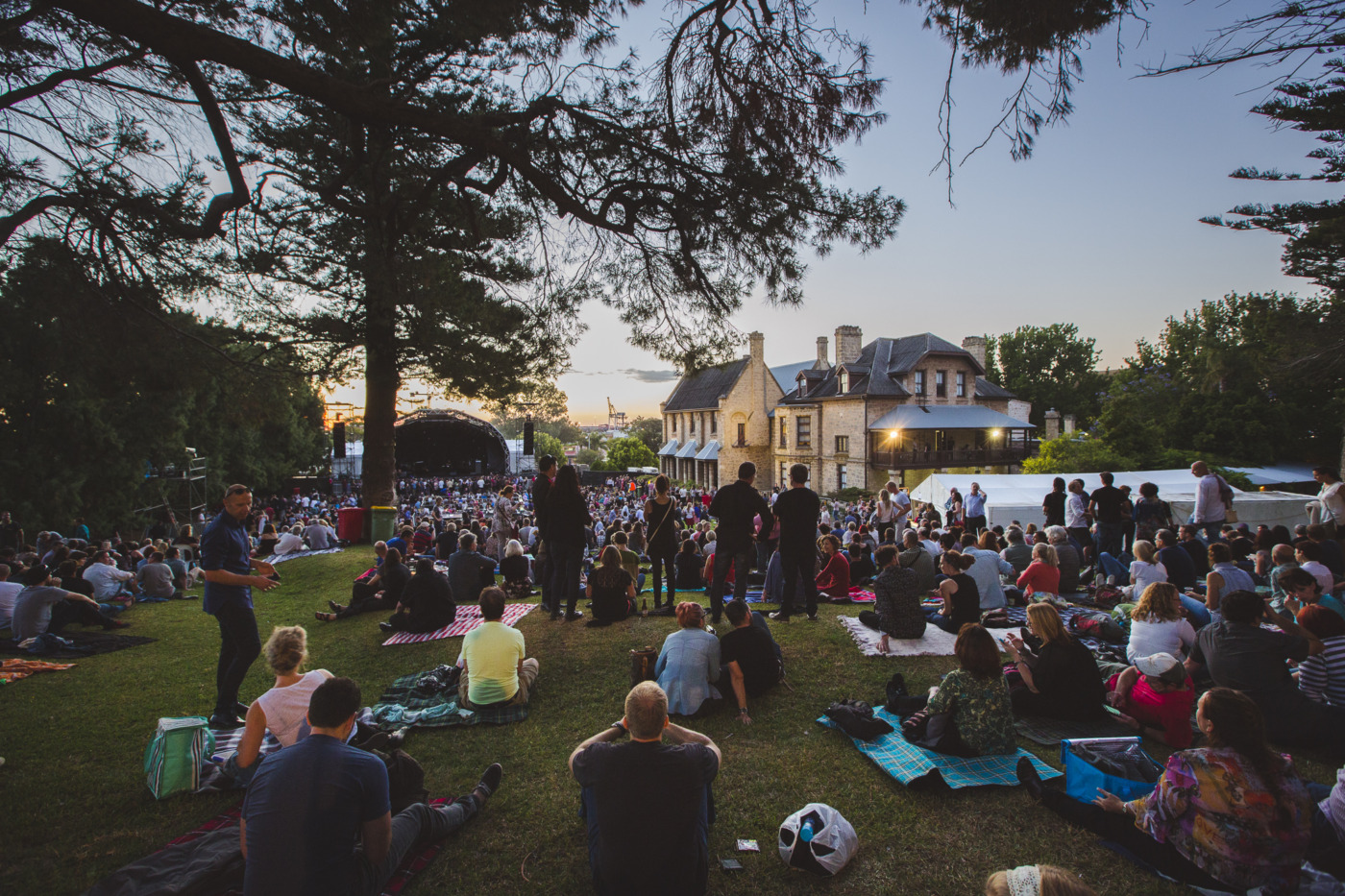Meet Erin Coates. Erin is a massive part of our exhibitions team and an artist in her own right. As our Special Projects Coordinator, not only does she curate, install and manage unbelievably large art projects – she also has a passion for climbing public art sculptures across the globe. We got the inside scoop on what drives her ahead of her upcoming exhibition Open Water opening at Moana Project Space on Friday 7 July.
Tell us about your practice. How did you first discover art and where has it taken you?
I’ve been an artist for as long as I can remember, although I don’t think I fit the category of a conventional studio-based practitioner. For me being an artist has also meant curating both in and outside of conventional gallery spaces, being a creative producer, gaining funding and also writing about art. Making art has always involved others and I often collaborate with specialists from other fields, including engineers, architects, sound artists, drone pilots and scuba divers to create my drawings, screen-based works and installations.
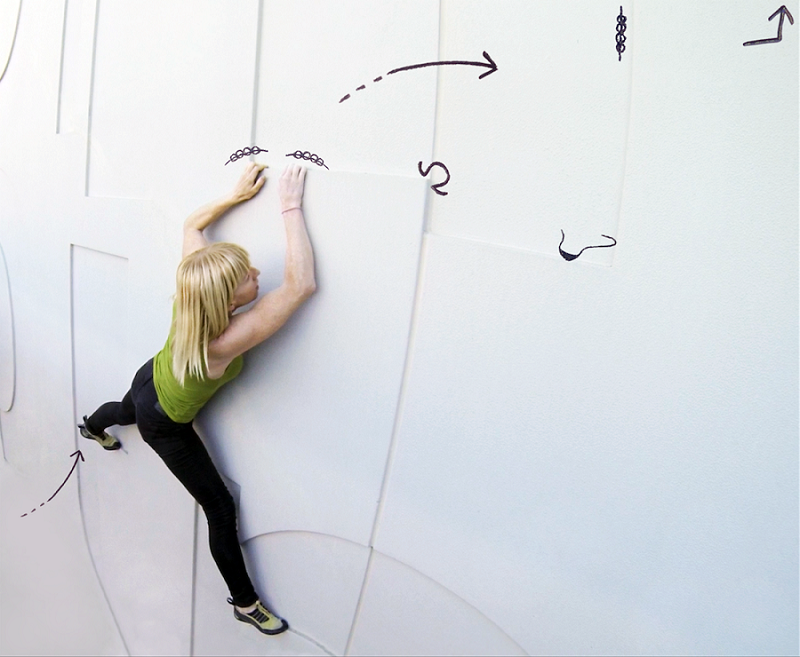
You’ve been a beloved member of the gallery team at Fremantle Arts Centre for the past eight years, working as a gallery attendant, exhibition coordinator, acting curator and most recently in the brand new role of Special Projects Coordinator. What’s this journey been like?
Being a part of the Fremantle Arts Centre team has been pretty incredible and I feel privileged to work in such an amazing organisation! FAC has allowed me to develop my career as an art coordinator, producer and curator, as well as supported my creative practice. It’s exciting to work on such a diverse and high calibre program of exhibitions and be a part of the programing. It’s hard to pin down exactly how it has influenced my artistic practice but without a doubt it has.
Your work is often bodily, from the grotesque-horror themes you’ve drawn on for your upcoming show with Moana Project Space to your combined art and climbing practice. What is it about the body and its fragile physicality that makes it such a fascinating art subject?
I think art is always trying to articulate something of the human condition, and our experience of the world is constantly mediated through our bodies. I’m interested this corporeal perspective, and even though I work across diverse ideas, I’m always concerned with how we interact with the world in this inescapably bodily way. I guess it’s slightly perverse but I enjoy amplifying elements of this to reveal our thresholds, and relationships to things.
I’m also really drawn to filmic representations of the sublime and how a sense of awe, beauty and utter terror can all exist in one moment. I guess that’s what I’m ultimately striving to capture when I make art. There are other reasons as well for my constant return to the ‘bodily’, like my background as a rock climber, my love of horror films and my interest in uncovering grisly local histories.
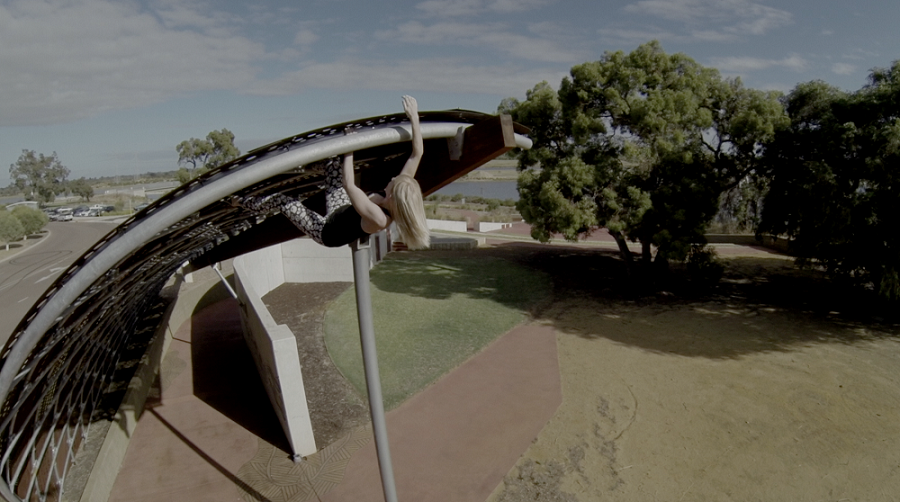
A brutal 1965 whaling accident inspired your upcoming exhibition Open Water: The Offering. How did you first come across this tale and where have you taken it in your show?
I grew up in Albany and my family has a long history of sea faring. My dad was a professional shell diver and we had lots of relics from wrecks, whale teeth and other marine curios in the house, so I’ve been surrounded by objects and stories from the ocean for a long time. The last commercial whaling station to close in Australia was in Albany, and although it was an indisputably unsustainable activity that had to end, I was still fascinated with the stories of people who worked on the whale chasers. They had a lot of knowledge about whales and a surprising amount of reverence for them.
For the show, I worked with another artist Anna Nazzari to research some of the stories and superstitions connected to whaling, as well as the waning art of scrimshaw – incising onto whale tooth. The work we’ve made as a result explores divergent narratives to the kind of heroic imagery that has typically been used to depict whaling. We’ve extended this into several film works that combine the unlikely genres of nature documentary with a kind of magic realist and phantasmagoric storytelling. We’re trying to find a unique lens to look at the history of whaling, as well as the incredible richness of local marine ecosystems.

Erin Coates and Anna Nazzari, Open Water: The Offering, 2017, HD video with stereo sound, duration 4:45 minutes. Composer: Stuart James
You’ve exhibited internationally, travelled across the globe and worked with legendary artists in some of Australia’s most remote Aboriginal communities. Hands down – what’s one of the most memorable things that’s ever happened to you?
That’s a really hard one to answer! Being with a group of senior Martu women in a place near Kunawarratji in the Western Desert was pretty special. It was a significant site for women only, and when we got there the Martu begun singing and performing the announcements required to enter this place.
Another really memorable experience in the Australian desert was rolling my car out in the middle of nowhere when I was a young and silly art student. It was very hot, we were on a dirt track and had no way of contacting anyone. I was with this French exchange student and we both thought we were going to die. We eventually got picked up by – believe it or not – a French tourist who was completely lost and we all ended up in a small mining town that had a male stripper troupe in town. It felt like a scene out of Wake In Fright. I think that experience has shaped my obsession with the Australian Gothic, and my tendency to be extremely well prepared when I travel.
What’s up next for you?
I’m working on a new set of drawings and a film work for a couple of shows later this year – the John Stringer Prize, and also Sounding Art at PS Art Space. The latter is a series of commissions by Decibel New Music Ensemble, who have asked artists to create artworks that will act as visual scores for compositions Decibel will create and perform during the show. I’m pretty excited about this one! I may also have my first public art commission coming up. I already know it’s going to be a big learning curve.
Erin’s latest exhibition Open Water: The Offering opens this Friday 7 July at Moana Project Space. The exhibition runs until 28 July 2017. Keep an eye out for Erin’s upcoming project In Cahoots: artists collaborate across Country, which sees leading Aboriginal and non-Aboriginal artists collaborate with Aboriginal arts centres across the country, opening at FAC on Friday 24 November.
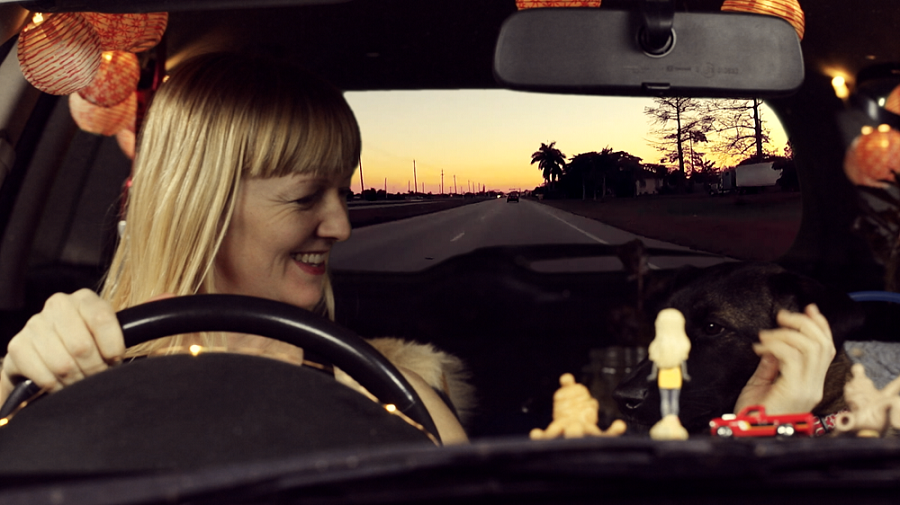
Erin Coates, Driving to the Ends of the Earth, 2016, video, duration: 11:03 mins, sound design: Stuart James, camera: Sohan Ariel Hayes, gaffer: Dion Borrett
The latest edition of FAC’s What’s On is now available to read online. Find everything that’s happening at FAC from July to Septmeber 2017, including Ian Strange | ISLAND, I WAS HERE and the Fremantle Arts Centre Print Award supported by Little Creatures Brewing. Plus catch shows from London Grammar and Pete Murray!
http://issuu.com/fremantleartscentre/docs/issuu_what_s_on_2017_q3?e=2557115/50842872
Opening Fri 21 Jul | 6:30pm | Free | Exhibition runs Sat 22 Jul – Sat 16 Sep
In Fremantle Arts Centre’s exhibition I WAS HERE the world is flipped upside down, long held beliefs are disproved and fact replaces fiction as seven artists grapple with what’s real, imagined or forgotten over time. Comprising photographic and sculptural works, I WAS HERE is a fascinating commentary on history itself and our relationship to the past.
Robyn Stacey (NSW) invites you into the homes of Australia’s most acclaimed artists in her gravity defying photographic series. Using a camera obscura, Stacey projects gorgeously coloured images of the outdoors into artists’ studios. This ancient optical phenomenon uses a pinhole to project an upside down image into a darkened box or room.
Historic icons are distorted in these shadowy, inverted rooms where fleeting moments of the present pass into history. Stacey inserts the Rose Seidler House’s benchmark modernist mural inside the iconic home – once the most talked about house in Sydney; visits Geoff Kleem’s Parramatta studio; and captures Wendy and Brett Whiteley’s stunning house in Lavender Bay.
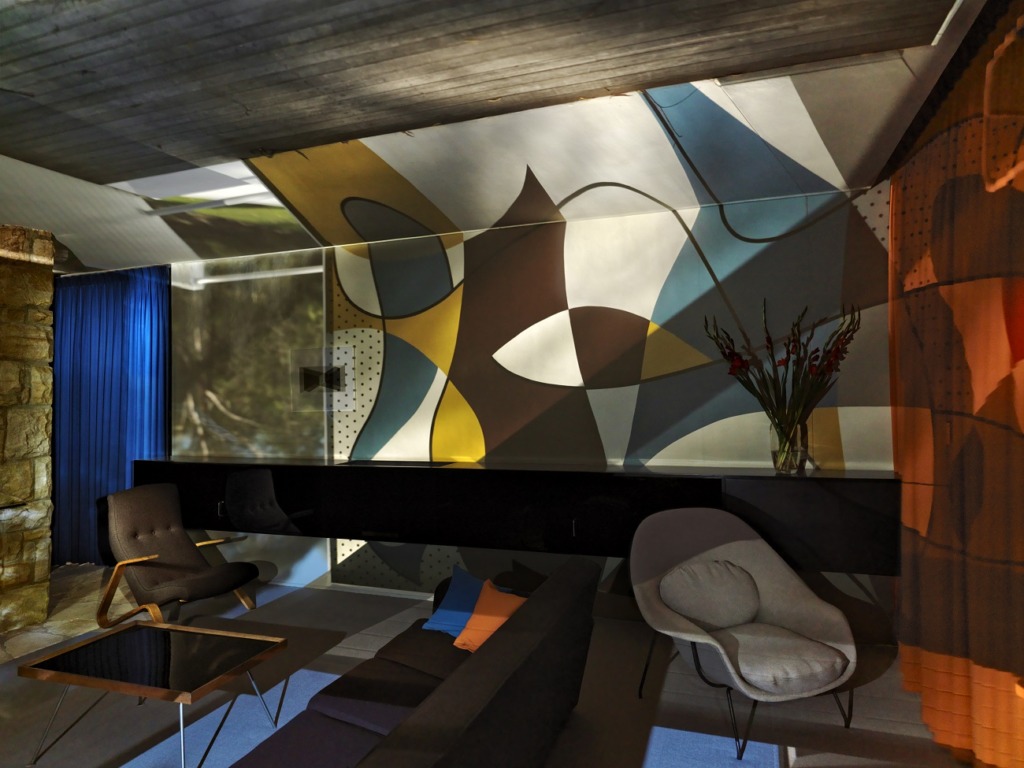
Robyn Stacey, Living Room, Rose Seidler House with Exterior Mural, 2016, Type C-Print, 110 x 146.7cm. Image courtesy of the artist and Stills Gallery, NSW
Emerging artist Tom Buckland (ACT) presents a constellation of peepholes, each hiding its own handmade mini-universe. Built to an impossible scale, these kitsch cardboard scenes are filled with plastic people and sinister machinery. Each imagined world plays out a myriad of dystopic futures. The free-standing universes speak to both the making of history and its machinations with audiences able to peek behind the viewing wall, revealing the artist’s surreal illusions.
Artists Alex Seton (NSW) and Amy Spiers (VIC) investigate how history is made and the ways in which false narratives become gospel. Examining stories of vanishing, Spiers’ campaign against whitewashing challenges the myths surrounding Hanging Rock. Immortalised by Joan Lindsay’s famous Australian novel Picnic at Hanging Rock and the 1975 film adaptation, Spiers looks at how these fictional legends are robbing Hanging Rock of its true Indigenous history.
Alex Seton (NSW) disproves the existence of an island, presenting scientific evidence of its non-existence. Sandy Island, once thought to lie east of Australia in the Coral Sea, was first ‘discovered’ in 1876 and remained on various maps for over a century despite repeatedly being undiscovered across the ensuring decades.
Shown alongside Seton’s marble sculptures, the artist plays with the transient nature of history as he undermines and unmaps landmarks and once-permanent monuments.
History repeats in Kate McMillan’s (UK) haunting photographic series Lost. In this modern version of the Pompeii legend, McMillan takes us to The Buried Village located on the shore of Lake Tarawera, New Zealand. In the late 19th century the site was obliterated by a devastating volcanic eruption and the surrounding villages buried.
While McMillan reflects on lost lives and fleeting histories, Wanda Gillespie (NZ) abandons the concept entirely. Gillespie amalgamates mythologies to create exquisite handcrafted objects which bear all the hallmarks of cultural artefacts but are in fact completely made up. Imagining societies that could have existed, her works are without history.
For Kokatha and Nukunu artist Yhonnie Scarce (SA) the scars of colonialism remain. In Florey and Fanny, Scarce depicts the stories of her grandmother and great-grandmother who worked in the domestic service industry during the late 1800s and mid-1900s.
Scarce’s traditional white aprons point to the life of servitude experienced by the matriarchs of her family. Each apron pocket holds hand-blown glass yams. This traditional bush food punches through the fabric, demonstrating the strength of the women’s cultural heritage and the legacies that they have fought to keep.
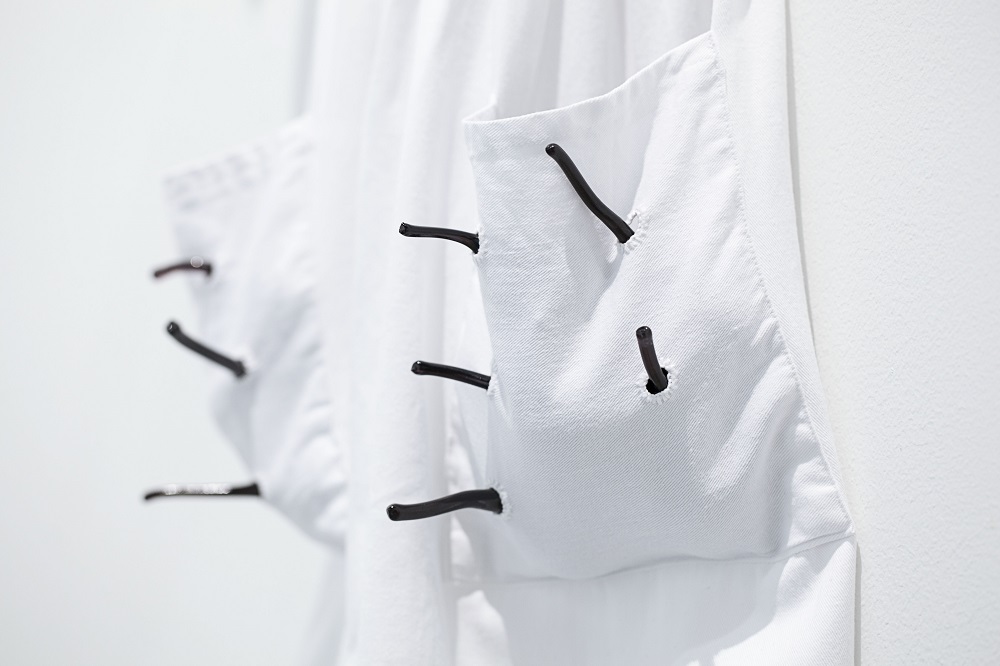
Yhonnie Scarce, Florey and Fanny, 2011, blown glass, 15 pieces, cotton aprons, dimensions variable
“The works in I WAS HERE are inextricably linked by the political nature of reporting and recording history, and in their shared material sensibility. The works are sculptural or photographic. They represent and create but not in the ways typically imagined,” said curator Anna Louise Richardson (WA).
“Sculpture and photography are associated with depicting truths and immortalising moments. It’s this fluidity and the occasional fabrication of history that the artists remind us of. Building on tales of abandonment, degradation and the repurposing of historical narratives, I WAS HERE lays out the endless remnants of a future in motion.”
Filled with surreal landscapes, lost villages and buried lives, all is not necessarily what it seems in I WAS HERE.
Walking through FAC’s grounds you might find Artist in Residence Sanne Koelemij creating gigantic colour fields across her handmade canvases. Hailing from Canberra, Sanne uses everything from cardboard to coffee cup lids and perspex, found during dumpster diving, to construct her large-scale abstract landscapes. Each final work and collaged ‘drawing’ is a kaleidoscopic example of Sanne’s ability to place colour into a joyful, cohesive whole. With an incredible eye for colour balance, Sanne can not only see colour but hear it through the neurological phenomenon synaesthesia.
Tell us a bit about your practice and how you first got into art.
I first got into art through my oma (Dutch for grandmother). I can remember visiting her home and having copious choices of watercolours, pencils and paper to work with. At this stage, representational paintings were everything I wanted to paint but after attending art school and developing my practice, my love for abstraction took over. My practice explores abstraction through painting, sculpture and drawing. My starting point is always ‘the grid’ whether it’s within the canvases I make or one that I’ve drawn, before I map saturated colour all over the surface. I like exploring illusions and patterns which warp depth of space and challenge the understanding of the artworks.
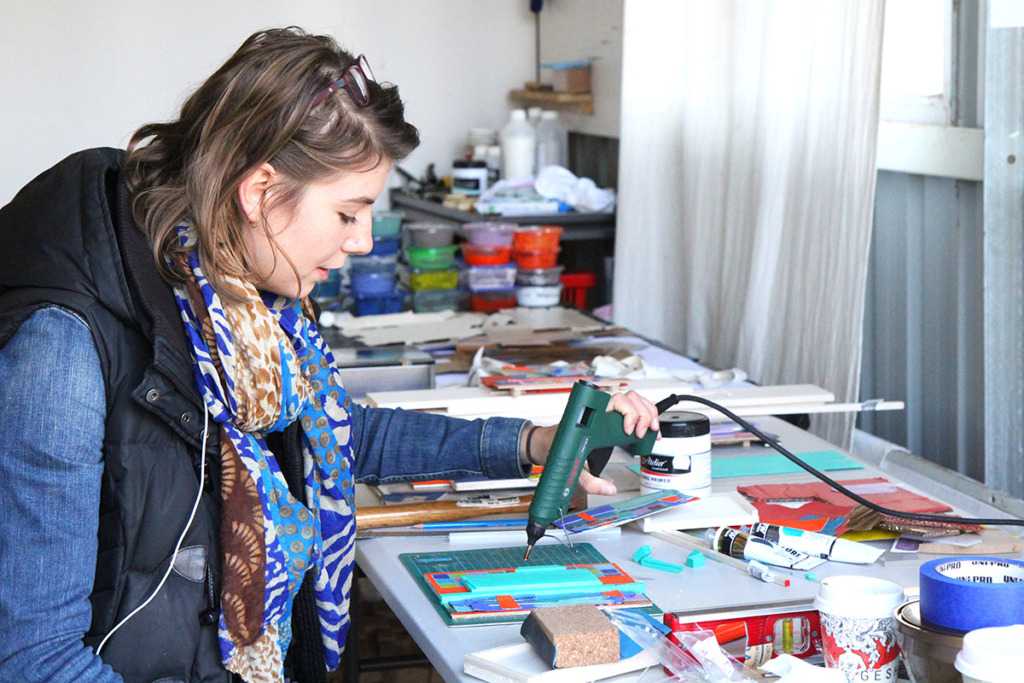
Artist in Residence Sanne Koelmeij creating her colour field collage ‘drawings’
What have you been working on while in residence?
I’ve been experimenting with new ideas since I moved in. There’re all in the developing stages so most of the artworks I’ve made are studies, models or drawings which will lead to larger paintings and installations. The works shown during FAC’s Open Studios on Sunday 25 June are the skeletons for the way I approach abstraction.
Contemporary art can be a complex subject. What’s something about your art practice that’s difficult to explain?
I get asked “why do I paint on cardboard/found/recycled materials?” all the time! The main reason is because I find irregular shapes really interesting to interpret and I don’t like working on rectangular canvases. It creates a system or rule, because a single piece of matter has its own shape and integrity which I try to maintain in my work. The other reason is because I want to engage with the objects and materials around me. Bringing ‘the everyday’ back into the gallery space creates a sense of familiarity with the things that surround us but often go unnoticed.
Where is your favourite place to create art and why?
Outside in the sun! I like using natural lighting when making my work. I particularly enjoy being at home so that I can remain in my pyjamas. Not that stepping outside the house has ever stopped me from walking out in my pyjamas!
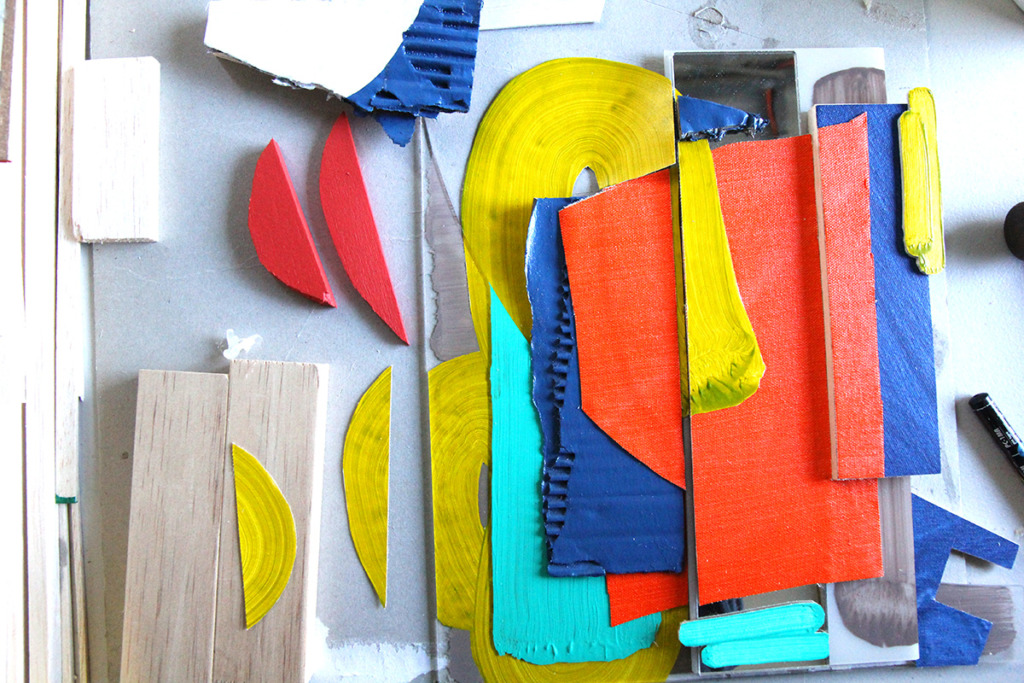
One of Sanne Koelmeij’s initial collage sketches, using found materials and perspex found during dumpster diving
FAC has a reputation for being the most haunted place in the southern hemisphere. What’s the scariest thing that’s happened to you at FAC?
The first time I heard the crows land on the tin roof of Studio 9. It was like a pack of party poppers going off. I jumped for my life and in the process tipped binder medium all over the floor.
Other than FAC of course, what’s your favourite gallery?
Staying in Fremantle, the Moores Building Contemporary Art Gallery was a beautiful space to visit. I loved that the gallery has maintained the integrity of its walls and the atmosphere was extremely welcoming. In terms of ‘must see’ exhibitions, I really enjoyed The Rise of Sneaker Culture at the Art Gallery of Western Australia that’s on until 4 September. I loved seeing some familiar kicks and the artists’ collaboration sneakers!
Meet Sanne in person at our Artist in Residence Open Studio this Sunday 25 June, 2–4pm. You’ll find her in Studio 9, in a shed bordering the beautiful grassed area that sits raised above our Front Garden.
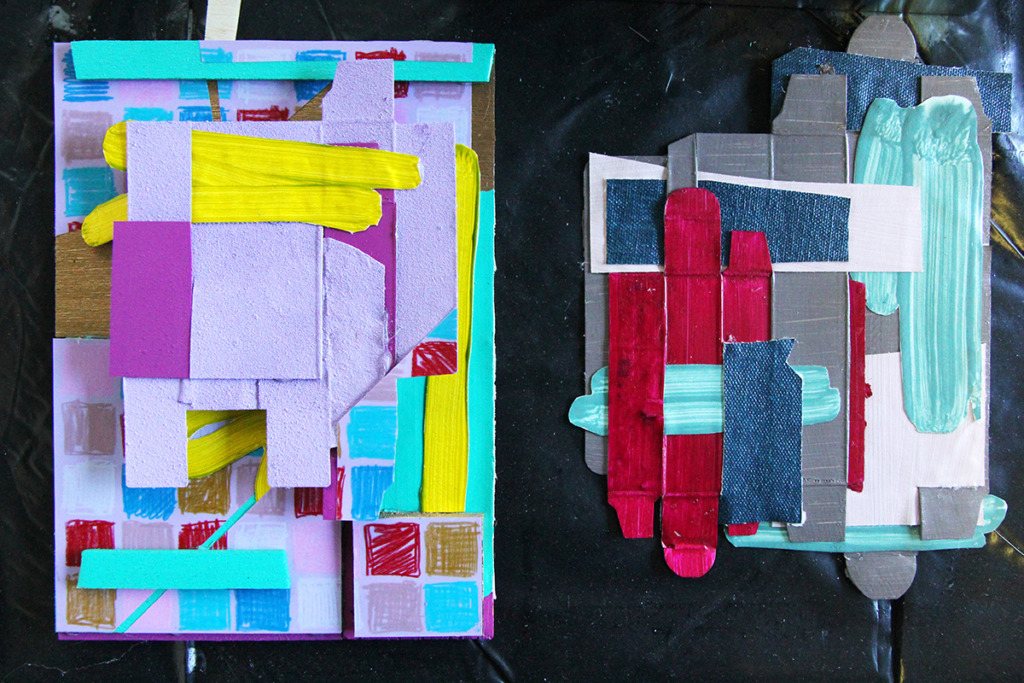
Sanne Koelmeij’s colourful collage ‘drawings’ which will inspire her final large-scale work
For everyone who’s ever broken a favourite cup, plate or precious ceramic sculpture, Artist in Residence Stephanie Hammill (WA) can relate. Stephanie’s ceramics practice is built around broken, distorted ceramics in need of some serious help or just a little bit of love. After studying the traditional Japanese repair technique Kintsugi, Stephanie has been carefully and laboriously repairing broken ceramics and collecting their stories along the way.
Tell us a bit about your practice and how you first got into art.
I got into art after having children. I wasn’t able to carry on with my previous career as an anthropologist due to the amount of travel involved, and I always enjoyed messing with play dough and thought that clay might be fun. I’ve been addicted to all things clay ever since trying my first class at Fremantle Arts Centre with Stewart Scambler.
What have you been working on while in residence?
I’m currently working on developing my Kintsugi practice. I studied the technique with a Japanese master practitioner last year and rapidly realised that it’s a lifetime’s practice to perfect. Kintsugi is a very traditional Japanese method of repairing broken ceramics using only lacquer (no epoxy or polymer glues). The break is then highlighted with gold. In my art practice I’m interested in exploring ideas of brokenness and repair in different forms. I’m also very interested in collecting stories that relate to broken ceramics. Just about everyone seems to have a favourite broken piece stashed in the back of a cupboard that they can’t bear to throw out.

Artist in Residence Stephanie Hammill with a broken plate that she is repairing using the Kintsugi technique
Contemporary art can be a complex subject. What’s something about your art practice that’s difficult to explain?
I find it difficult to explain how much work goes into a Kintsugi piece – it’s the antithesis of fast-paced, throwaway consumer culture. It requires months of laborious work to meticulously add layers upon layers of lacquer. There is so much bad, blobby Kintsugi work on the internet and I would love to educate the public as to what ‘proper’ Kintsugi looks like.
Where is your favourite place to create art and why?
I actually love Fremantle Arts Centre – from my earliest days as a student to being an Artist in Residence, FAC has nurtured my career and broadened my horizons as well as giving me a new purpose in life. There’s a certain atmosphere about the place which encourages creativity and new beginnings.

Artist in Residence Stephanie Hammill wheel throwing in FAC’s Ceramic Studio
FAC has a reputation for being the most haunted place in the southern hemisphere. Have you had any unsettling moments while in residence?
I think we’re lucky being based up in the old laundry in the top car park. I can’t say I’ve ever had any ghostly experiences. However, when the Ceramics Studio was down in the main building it used to be a fairly frequent experience to have the hairs on the back of your neck stand up in the old kiln room!
Other than FAC of course, what’s your favourite gallery?
My favourite gallery in the whole world is the ceramics collection at the Victoria and Albert Museum in London. It’s quite honestly the most amazing collection of ceramics, from pre-history to modern times, I have ever seen. My second favourite gallery would have to be the Pitt Rivers Museum in Oxford for its collection of cultural and social artefacts.
Meet Stephanie and discover what she’s been working on at our Artists in Residence: Open Studio this Sunday 25 June, 2–4pm. If you have a broken ceramic story that you would like to share with Stephanie, she’d love to hear from you. Email info@stephaniehammill.com with your story and a photograph of your broken ceramic. Stephanie is also one of our regular ceramicist tutors. To learn more about her courses and enrol visit our courses program.

Stephanie Hammill’s ceramics collection
Fremantle Arts Centre presents the world premiere of internationally acclaimed artist Ian Strange’s latest exhibition ISLAND. Born and bred in the Perth suburbs, Strange is known for his subversive, site-specific interventions on suburban houses. Based in New York since 2009, Strange returns home to debut his most in-depth exploration of home. Created in the wake of the American housing crisis, ISLAND offers a provocative and unsettling look at our deep psychological relationship to home.
Strange’s fascination with home has been a focus of his practice for many years. Working with the foreclosed houses of America, historic buildings in an economically stagnant Poland and Christchurch’s earthquake ravaged homes – Strange explores home as a universal ideal. His darkly surreal installations have seen the artist encase buildings in wallpaper, black out entire houses with paint and install a crash landed home outside the Art Gallery of South Australia.
ISLAND is the latest iteration of the artist’s ongoing investigation into home, unveiling two years worth of work on foreclosed homes in Ohio’s Rust Belt region. Approaching the iconic symbol of the suburban home through the metaphor of the desert island – a place of refuge, protection and personal sovereignty but simultaneously entrapment and isolation – Strange carried out his signature ‘interventions’ on three houses which from the outside, perfectly embody the ideals of the American Dream. Painting the words “SOS”, “RUN” and “HELP” in giant lettering on these buildings, Strange exposes the darker truth belying their perfect exteriors.
These powerful statements point to the inherent instability of the home that much of Strange’s work reveals. The values of family, community and safety are built into the architecture of the suburban home but Strange highlights how, for many, that’s intrinsically fragile or entirely false.
For this exhibition Strange has adopted a new multi-disciplinary approach, presenting a sculptural house deconstruction made from the removed side of a now-demolished home in New Jersey, photographs he has marked with ink and paint, and found artefacts collected at the intervention sites.
ISLAND also includes a major new site-specific installation. Working within one of FAC’s galleries, Strange will create a large-scale sculptural intervention based on an abstracted house framework.
“I’ve always been interested in looking at the home as an island – simultaneously a place of safety and refuge, but also a space where you can become trapped and wish to escape,” said Strange. “By incorporating these now-demolished American homes and presenting my research and artefacts I want to reveal the home’s vulnerability and to question it as a symbol of stability.”
FAC Curator Dr Ric Spencer said: “It’s a privilege to have Ian showing a new body of work at FAC. To bring Ian’s work back to his home town for a world premiere is a thrill. This series of works is compelling on a global scale, showing both the fragility of refuge and the colossus that is the global financial market and its reach into our lives.”
“These are universal issues of today and the dramatic, striking and compassionate way in which Ian has approached these concerns in ISLAND clearly shows why he has a rapidly growing reputation as an artist with a truly international reach.”
About the Artist
Ian Strange is a New York-based multi-disciplinary artist who rose to international prominence in the street art movement in the early 2000s. Surpassing his graffiti days, Strange’s work has since expanded to explore architecture, space and notions of ‘home’ on a colossal scale. His practice includes large-scale multifaceted projects resulting in photography, sculpture, installation, site-specific interventions, film works, documentary works and exhibitions. His studio practice includes painting, drawing and on going research and archiving projects.
Strange has held solo exhibitions at the National Gallery of Victoria (Suburban, 2011-2013), The Canterbury Museum (Final Act, 2013) and participated in the 2014 Adelaide Biennial of Australian Art at the Art Gallery of South Australia with LANDED, a commissioned sculptural installation on the forecourt of the gallery. SHADOW (2015-16) was a large-scale project incorporating suburban homes, documented in film and photography; and ZŁOTY was a sitespecific intervention onto the exterior of a historical building commissioned by the Intytucja Kultury, Katowice, Poland (2015). In June 2016 he held a solo exhibition of his SUBURBAN body of work in New York with NYC based arts organisation Standard Practice. His investigations into the themes of home and suburbia were recently the subject of the six-part ABC documentary series HOME: The Art of Ian Strange.
Brit Award-nominated three-piece London Grammar return to Australia for a massive national headline tour this September. The tour will see Hannah Reid, Dan Rothman and Dot Major perform shows across four states in some of the country’s most esteemed venues and arenas, including Fremantle Arts Centre on Saturday 16 September.
London Grammar first captivated Australian audiences with their debut performance at the 2013/14 Falls Music & Arts Festival. Their debut album If You Wait hit #2 on the ARIA Albums Chart in late 2013, selling over two million copies worldwide.
In 2015 the trio returned to Australia, playing to sold-out arenas with The Music declaring: “with Reid’s vocals pushing the performance to new heights, elating every soul and leaving everyone hoping that it’s not as long between visits for London Grammar”.
Fresh from the headline slot at the 2016/17 Falls Music & Arts Festival, London Grammar are back in the country with their brand new album Truth Is A Beautiful Thing.
Featuring the stunning 32-piece City of Prague Philharmonic Orchestra across the record, the album was produced by music giant Paul Epworth – multiple Grammy award winning producer for the likes of Florence & The Machine and Adele. London Grammar also teamed up with friend and Mercury-nominee Jon Hopkins (Brian Eno, King Creosote) on the sweeping lead single Big Picture, and LA-based Greg Kurstin (Sia, Beck), Tim Bran and Roy Kerr.
Special guests to be announced! Tickets on sale 9am, Fri 16 June from fac.org.au.
Melbourne-based video artist Claire Robertson returns to the remains of the temporary Pilbara mining camp that she and her family called home during the 1980s in her upcoming exhibition Far From Here. Drawing on colonial narratives and following the collapse of the Australian mining boom, Claire has created a haunting installation of cinematic proportions. Shot on-site, she’s captured the uninhabited demountable villages as they sit in stark contrast to the vast, endless horizon. Claire gave us an insider’s take on life in a mining camp ahead of the exhibition opening on Friday 26 May.
You had a really unusual childhood, growing up in a Pilbara mining camp. What was it like for you as a kid?
I was quite young when we lived on-site at a gold mine in the Pilbara Region. Dad was the manager and our family of five lived in a two bedroom donga. I think as kids we were happy. There were other kids living there at different times and we had a poodle. It was mostly men and there was a lot of drinking but all in all it was like a small community, one with its own dark secrets but a community of sorts. Dad wanted to start a caravan park on-site but got into trouble from the mining company. They said that it wouldn’t look good to shareholders. So I guess our experience of living on-site was pretty different to the fly-in, fly-out of today.

Claire Robertson, Far From Here, 2016, still from video. Image courtesy of the artist
How do you reconcile a place that was your childhood home next to the empty, industrialised mining camps that remain?
As a child we moved from mining camp to mining camp and when we finally stopped and settled it was my father who kept travelling and moving, coming home for what felt like moments in his fly-in fly-out routine.
I went back to the camp where we used to live as part of my research for Far From Here. On my first trip back, I took my mum with me. It was quite an emotional experience for her. Life was not always easy for her living on-site. Every day at sunrise my mum would go running. It was her only escape from us, from the isolation of being one of few women on-site and the only one without a job on the mine. That landscape symbolised a lot for her. She would run past the lone grave of a woman who died from heat exhaustion on her trip out to meet her husband from Europe in the 1800s. As we entered the gates she tearily whispered “I never thought I would come back here”.
We visited the location of a nearby mining camp that we used to come to for football games or other events. It was gone, just a few broken slabs of concrete, flattened and faded beer cans and hidden scraps of metal amongst the spinifex. The roads were slowly fading as the bitumen gradually washed away. This feeling of abandonment felt ever present, like a visual depiction of the fall of the mining boom. But the deeper I looked, the more I realised that we were never really there. We were only ever visiting.

Claire Robertson, Far From Here, 2016, still from video. Image courtesy of the artist
How does the stark desert landscape sit alongside these industrial villages?
As part of my research I went and stayed on a functioning fly-in fly-out mining camp for a few days where I followed different workers in their everyday duties. The workers’ accommodation where I stayed was reminiscent of a cheap roadside motel. The windows were barred and small and if you closed the blackout curtains, you could be almost anywhere. The structures close out the landscape. They are not intended to encourage connection to place. After all within a year or so they will disappear, leaving only scars on the hills. It’s a strange contradiction to the tourist glamping in Karijini National Park nearby. Tourists are directed along strict paths to lookout points, perfect for postcard shots.
For many of us who are new to this land, we experience the landscape at a distance. We haven’t moved on from the thinking of our colonising ancestors. You only have to look at Australian cinemas’ depiction of the outback in films like Wake in Fright. I say many of us because I don’t want to generalise. I stayed on a cattle station where the landscape was not just under the nails but in the very heart and core of the people who lived and worked there.
While I was developing this work I was in conversation with Clothilde Bulleen, who wrote an accompanying essay for the show. I was talking about the way we inhabit nature. She kindly reminded me of my misunderstanding. We don’t inhabit nature, we are nature. We aren’t in the landscape, we are part of the landscape. We feature momentarily in its life but we are not separate. Throughout history filmmakers have used the natural landscape as a metaphor for emotional space. It is this internal landscape or landscape of the mind that I often explore within my work.
Far From Here opens 6:30pm, Friday 26 May. Exhibition runs Saturday 27 May – Sunday 16 July 2017.
Meet Layne Dhu-Dickie, the youngest artist to ever be showcased in the Revealed Exhibition: New & Emerging WA Aboriginal Artists. Revealed features the next generation of Aboriginal artists from some of the most remote locations in WA, alongside regional and metropolitan artists. Spinifex Hill Artists’ Layne is 12 years old and the creative brains behind Captain Hedland. The comic book series charts the adventures of the valiant Captain Hedland and his efforts to fight drug and alcohol addiction in Layne’s home of Port Hedland. Revealed runs until Sunday 21 May.

Layne Dhu-Dickie (Spinifex Hill Artists), Captain Hedland (page 1), 2017, texta on arches paper, 61 x 42cm

Layne Dhu-Dickie (Spinifex Hill Artists), Captain Hedland (page 2), 2017, texta on arches paper, 61 x 42cm

Layne Dhu-Dickie (Spinifex Hill Artists), Captain Hedland (page 3), 2017, texta on arches paper, 61 x 42cm

Layne Dhu-Dickie (Spinifex Hill Artists), Captain Hedland (page 4), 2017, texta on arches paper, 61 x 42cm

Layne Dhu-Dickie (Spinifex Hill Artists), Captain Hedland (page 5), 2017, texta on arches paper, 61 x 42cm

Layne Dhu-Dickie (Spinifex Hill Artists), Captain Hedland (page 6), 2017, texta on arches paper, 61 x 42cm

Layne Dhu-Dickie (Spinifex Hill Artists), Captain Hedland (page 7), 2017, texta on arches paper, 61 x 42cm

Layne Dhu-Dickie (Spinifex Hill Artists), Captain Hedland (page 8), 2017, texta on arches paper, 61 x 42cm

Layne Dhu-Dickie (Spinifex Hill Artists), Captain Hedland (page 9), 2017, texta on arches paper, 61 x 42cm

Layne Dhu-Dickie (Spinifex Hill Artists), Captain Hedland (page 10), 2017, texta on arches paper, 61 x 42cm
Opening Friday 26 May | 6:30pm | Free | Exhibitions Run Saturday 27 May – Sunday 16 July
Art lovers will be generously rewarded at Fremantle Arts Centre’s winter exhibitions which span elegant painting by revered Fremantle realist Marcus Beilby; otherworldly fleshy figures by internationally acclaimed artist Jess Johnson; the in-your-face, street-inspired style of local duo Trevor Bly and Patrick Doherty; and a diverse showcase of contemporary Australian video art.
FAC partners with the Revelation Perth International Film Festival, one of Australia’s best independent cinema festivals, for the first time to present Warp, a selection of video works by eight leading and emerging artists from Western Australia and Victoria. The videos in Warp reflect on the tension between life experienced online and life led in the real world. For some individuals it is the real world that becomes alien after huge hours in front of a screen absorbed in the digital world. An eerie lack of tangibility in the online domain permeates and entangles ‘real world’ activities, as both arenas feed on each other in continually expanding, provocative and warped ways.
Curated by Amy Majoram (VIC), Warp artists Tom Blake (WA), Ellen Broadhurst (WA), Dale Buckley (WA), Lou Hubbard (VIC), Georgie Mattingley (VIC), Michael Meneghetti (VIC), Georgie Roxby Smith (VIC) and Andrew Varano (WA) have been selected for their unconventional use of the medium.
FAC Director Jim Cathcart said: “One of FAC’s priorities is to provide a platform for artists and foster conversations about how we make art in WA, and nationally. Revelation has an unmatched reputation for presenting fascinating works that are thrillingly inventive and subversive. They’re constantly expanding the potential of what screen-based media can do and we’re excited to be partnering with them.”
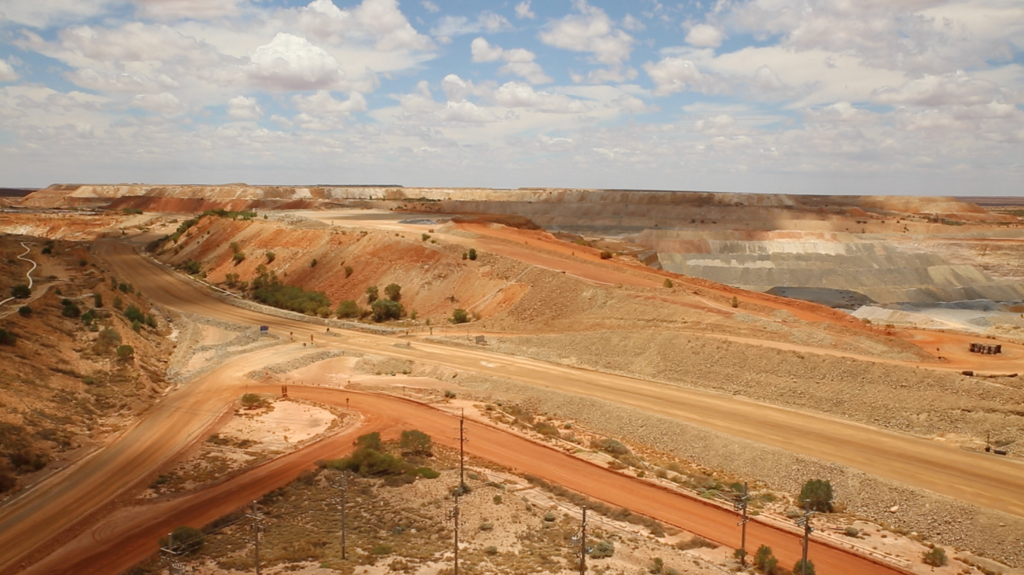
Claire Robertson, Far From Here (detail), 2016, still from video. Image courtesy of the artist
As a counterpoint Claire Robertson’s (VIC) stunning cinematic video Far From Here, vast in scale and scope but rooted in place and memory, portrays her return to the remains of the temporary Pilbara mining camp her family called home in the 1980s. Elegantly shot with a haunting sound design by acclaimed WA composer Tilman Robinson, Far From Here examines a colonialist relationship to the WA landscape and asks what it means to really “inhabit place”. Far From Here was originally developed for Next Wave Festival 2016, Melbourne.
Currently showing at Carriageworks as part Sydney’s landmark The National: New Australian Art, New York-based artist Jess Johnson (NZ/US) brings her gorgeously drawn world to FAC in her first WA show.
For Hex Nemesis, Johnson will transform FAC’s gallery with a floor-to-ceiling installation, rich with impossible architecture and an abundance of humanoid figures. The exhibition also features the artist’s video work and a suite of drawings as she invites audiences into her mind-bending alternative reality.
Internationally collected and exhibited and scheduled to show at Dark Mofo 2017, Hobart, Johnson is an exciting force in the global art world.

Jess Johnson, Municipal Wurm and Sapir-Whorf, 2015, gouache, pen, fibre-tipped markers on paper, 43.8 x 33.8cm. Private collection, Melbourne. Images courtesy and copyright of the artist
We celebrate a career spanning four decades in Marcus Beilby’s Sightings. The highly regarded Fremantle realist painter portrays intimate moments of ordinary people in the familiar settings of the local shop, railway station and pub. Sightings offers a particular representation of Fremantle life and architecture from the late 1970s to now, articulated through Beilby’s ironic gaze. Sightings is curated by City of Fremantle Art Collection Curator André Lipscombe.
Finally, One street from happiness sees WA urban artists Trevor Bly and Patrick Doherty continue to explore the culture of Perth’s northern suburbs and the collision of graffiti culture and contemporary art. Featuring experimental prints and paintings with raw, aggressive and sometimes sad symbols, the works reflect on Bly and Doherty’s time as graffiti artists in Craigie, as they look back on a history that is fast being sanitised.
FAC’s winter 2017 exhibitions will be opened by Jack Sargeant, Program Director, Revelation Perth International Film Festival.
For media enquiries contact Communications Assistant Sam Leung at saml@fremantle.wa.gov.au or 08 9432 9565.
